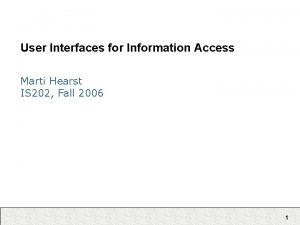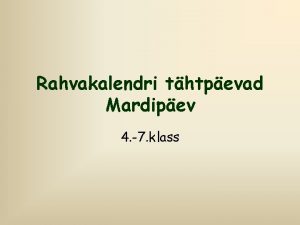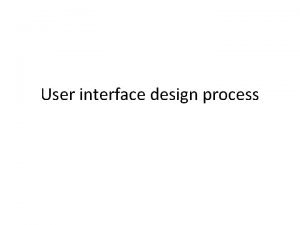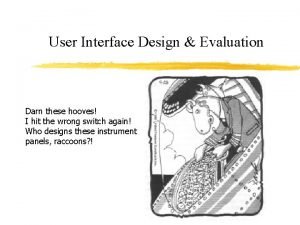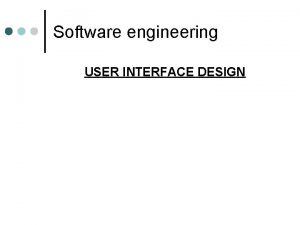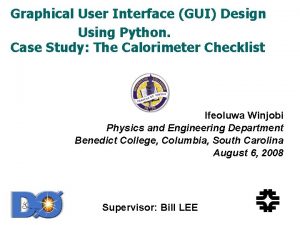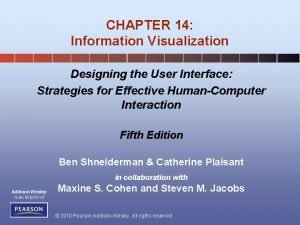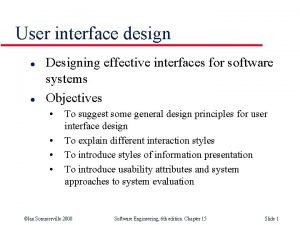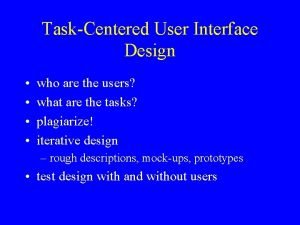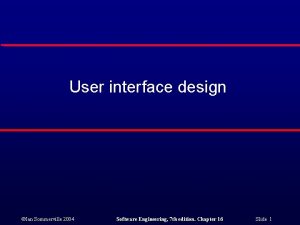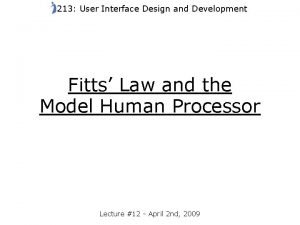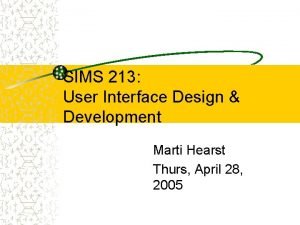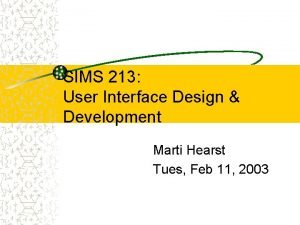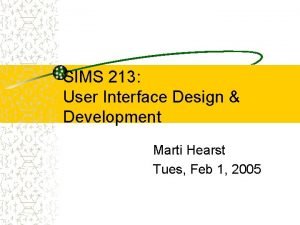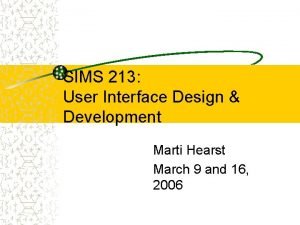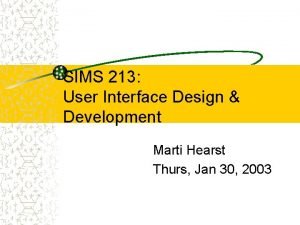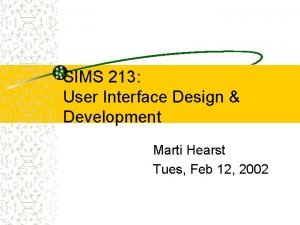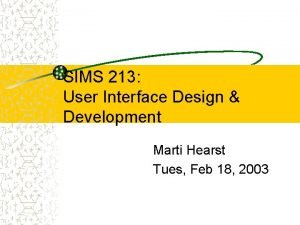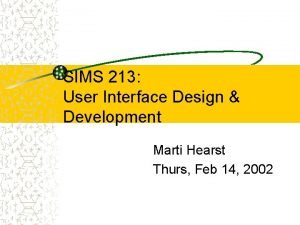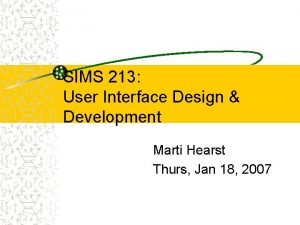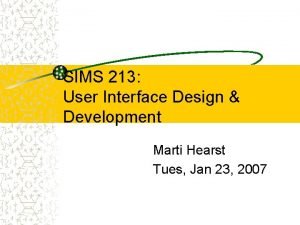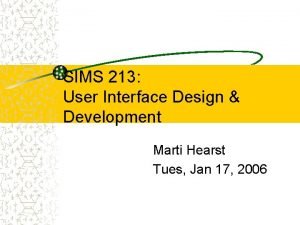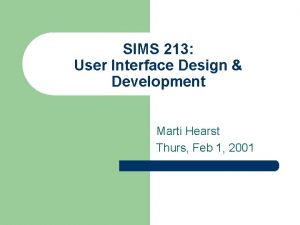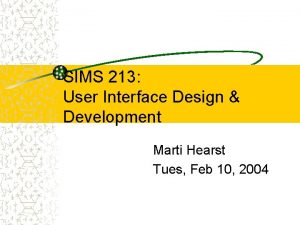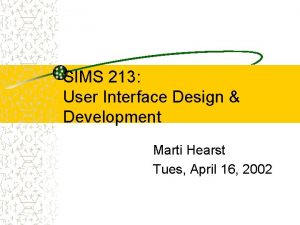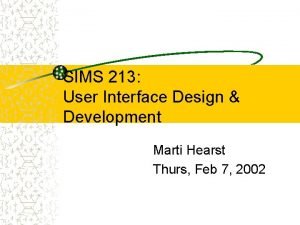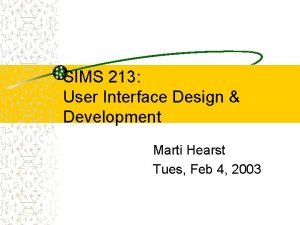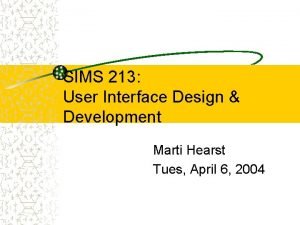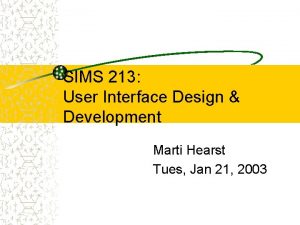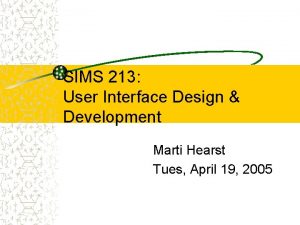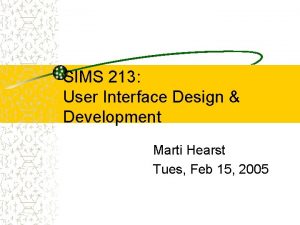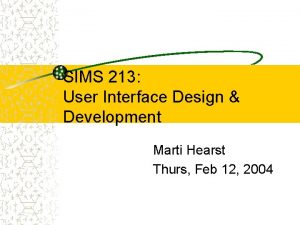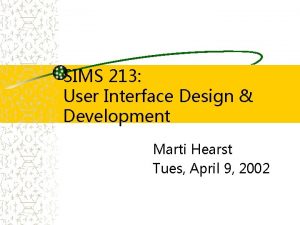SIMS 213 User Interface Design Development Marti Hearst























- Slides: 23

SIMS 213: User Interface Design & Development Marti Hearst Thurs April 19, 2001

Today l 2 Does human-computer social interaction differ from human-human interaction?

Building Automated Agents l Computer scientists trying to build believable agents: – – ignore the vast psychological literature on personality assume representations need to be rich l l 3 need sophisticated natural language processing and intelligent interaction need realistic graphics, movement, and behavior

The Computer Are Social Actors Research Paradigm l CASA: Computer are Social Actors – l Main discoveries: – – 4 by Nash, Reeves, Moon, Fogg, et al. Social rules guiding human-human interaction apply equally to human-computer interaction This kind of response can be invoked in humans using very crude representations of agentness.

A Survey of Responses l People apply politeness norms to computers – When asked to evaluate a progam’s performance: l 5 people (generally) are “nicer” when “asked” by the program itself than when “asked” by a program running on a different computer

A Survey of Responses l People apply self-praise rules l l l – 6 People (generally) think more highly of a program that is “praised” by a program running on another computer than when the program “praises” itself Computer programs that “criticize” are preceived as “smarter” than those that complement Computer programs that praise themselves and criticize others are seen as less friendly than the converse. These are consistent with findings in the social psychology literature.

A Survey of Responses l Artificial application of “team labeling” has similar social bonding effects with human and computer teams – If people are assigned to a “team” with a computer program, they are l l l – 7 more likely to cooperate with the program view the program as more competent view the program as being more similar to themselves than in the control condition (working individually)

Attempts to Explain l Counterclaims: – This only happens with l l – When people use the systems l l 8 people who do not understand how computers work people who are socially or otherwise dysfunctional. they are adopting the perspective that they are interacting with the designer of the program Nass et al. conducted studies that suggest that these are not the case.

Attempts to Explain l Nass et al. conclude that the explanation is: – – human-computer interaction is fundamentally social not anthropomorphic: l – – human users behave as if computers were human, even though they know they are not ethopoeia: l 9 “tending to believe computers are like people” “assignment of human attitudes, attentions, or motives to non-human objects”

Defining Personality l Personality study in psychology: – – – Provide a systematic account of the ways in which people differ from one another Often study how to reduce personality traits into a small set of dimensions Five orthogonal dimensions are currently in vogue: l l 10 l (I) (III) (IV) (V) extraversion especially important agreeableness for inter-personal relations dependability emotional stability openness to experience

Defining Personality l Focus on the inter-personal dimensions: – extraversion l l – agreeablenes l l 11 aka power, status, control dimension ranges from dominant to submissive aka affiliation, warmth dimension ranges from warmth to hostility

Defining Personality l The extraversion dimension – dominance: l l l – submissiveness l l 12 able to give orders talks others into doing what s/he wants often assumes responsibility easily led lets others make decisions avoids responsibility Use these behavioral marks to explore if a computer program can exhibit a personality along a single dimension.

Hypotheses in Dominance Study l Hypothesis 1: – l Participants will perceive a computer with dominant traits as being dominant and vice versa regarding submissive Hypothesis 2: – Computers with dominant characteristics will not be perceived differently with respect to affiliation (warmth/hostility) than submissive ones l l Hypothesis 3: – Computers with dominant characteristics will not be perceived differently with respect to competence than submissive ones l 13 because these traits are orthogonal in human-human interaction IBID

Hypotheses in Dominance Study l Want to see if people respond to computer “personalities” in the same way they respond to human personalities – l Hypotheses 4 and 5: – – 14 studies show that people prefer others with similar traits (generally) Participants will be more favorably disposed towards programs that match their personality Participants will be satisfied with the interaction with the programs that match their personality

Experiment Design l 48 participants – – undergrads classified using a personality scale l l 2 x 2 between-subjects design – factors: l l – 15 24 dominant, 24 submissive selected – computer personality participant personality levels? all conditions balanced for gender

Procedure l Task: Desert Survival – l Two computer monitors: – – l l In actuality, all participants in a given condition saw the same content Participant and computer left alone to exchange confidence levels Afterwards, participant taken to another room – 16 neutral: see the original list dominant/submissive computer: proposes its own list Both views allow listing of confidences from 1 -10 Particant enters info, then “sends” to other computer Participants told the computer’s responses were contingent on what the participant typed – l first rank 12 objects according to importance for surviving in the desert (using pencil and paper) – Makes a final ranking Fills out a questionnaire

Creating the Perception of Personality l Phrasing of text – – l Confidence levels – – l – dominant: always went first (discussed item before partipant did) submissive: discussed item after participant did Computer name (confirmed by pre-testing) – 17 dominant: average confidence of 8. 0, s. d. 0. 8 submissive: average confidence of 3. 0, s. d. 0. 8 Interaction order – l dominant: assertions and commands submissive: questions and suggestions – dominant: Max submissive: Linus

Measures l Dependent variables – – l program likeability program competence Measured via questionnaire, 10 pt Likert scale – – (Describes very poorly … Describes very well) “For each word below, indicate how well it describes the computer you just worked with. ” l – “For each word below, indicate how well it describes your interaction with the computer” l – 18 assertive, friendly, helpful insightful, … enjoyable, interesting, … Other questions on satisfaction with the interaction and about the similarity between the computer’s interaction style and their own.

Results l l Full-factorial ANOVA All 5 hypotheses were supported – – dominant computer was seen as such, same for submissive no difference between dominant and submissive computers and their scores on affiliation dimension l – – – 19 submissive participants perceived the computer in both conditions to be friendlier than dominant participants no difference between dominant and submissive computers and their scores on competence dimension participants preferred the program that matched their personality types, and found them more competent participants preferred the interaction with the program that matched their personality type

Discussion l Personality is powerful – easy to manipulate – can provide cues for complex social behavior – people can respond as if the program has a personality Suggests a procedure for research: – select a social science finding for human-human interaction – replace one human with a program – see if humans continue to interact in the same manner – l 20

Open Questions l l l 21 Some psych findings suggest that the more people interact with each other the more similar they become … How would people respond to inconsistent personality in a program? What exactly is personality?

Silicon Syncophants l Will the same thing happen with humancomputer interaction and – – 22 genuine praise? false flattery?

Summary l l People seem to treat interactive computers as if they were social actors What are the implications? – – 23 for design of UIs for understanding social interaction?
 Marti a. hearst
Marti a. hearst Marti hearst
Marti hearst Mardipäeva kombed
Mardipäeva kombed User interface design in system analysis and design
User interface design in system analysis and design Data input methods in system analysis and design
Data input methods in system analysis and design Principle of input design
Principle of input design User interface design cycle
User interface design cycle User interface in software engineering
User interface in software engineering User interface analysis and design
User interface analysis and design Graphical user interface design principles
Graphical user interface design principles User interface design and implementation
User interface design and implementation Atm user interface design
Atm user interface design User interface design and evaluation
User interface design and evaluation Mode based vs modeless interface
Mode based vs modeless interface User interface design in software engineering
User interface design in software engineering Python gui design
Python gui design Visualization in user interface design
Visualization in user interface design Recoverability in user interface design
Recoverability in user interface design User interface design steps in software engineering
User interface design steps in software engineering Task centered user interface design
Task centered user interface design User interface design process in software engineering
User interface design process in software engineering Labview user interface design examples
Labview user interface design examples User interface design process in software engineering
User interface design process in software engineering Fitts law user interface design
Fitts law user interface design

